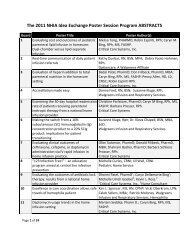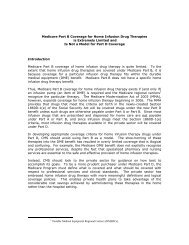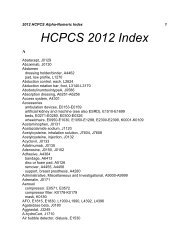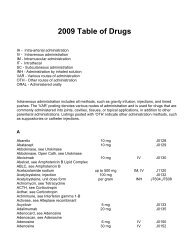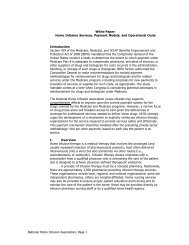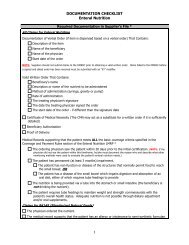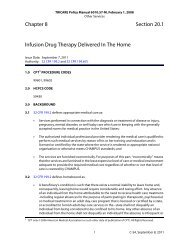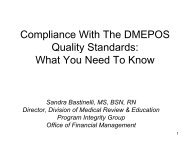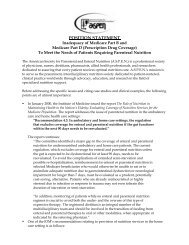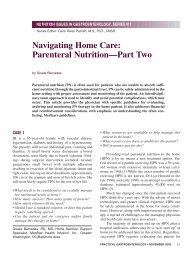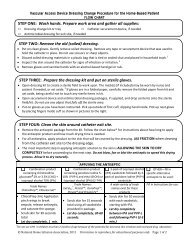Primary care case management (PCCM) programsNearly as many states have a PCCM program as have c<strong>on</strong>tracts with MCOs. Thirty-<strong>on</strong>e states operatePCCM programs, in which PCPs, by c<strong>on</strong>tract with the state, agree to provide, manage, and m<strong>on</strong>itor theprimary care of <strong>Medicaid</strong> beneficiaries who select them, or, in some cases, are assigned to them. Inadditi<strong>on</strong> to serving as a medical home for primary and preventive care, PCPs are c<strong>on</strong>tractuallyresp<strong>on</strong>sible for authorizing referrals when specialty care is needed. Most states pay PCPs a smallm<strong>on</strong>thly fee for case management in additi<strong>on</strong> to regular fee-for-service payments. A quarter of statesinclude a pay-for-performance element in their payments to PCPs.Many states c<strong>on</strong>tract for PCCM administrative services. Over half the states with PCCM programsreported that they have PCCM administrative services c<strong>on</strong>tracts and, in a few cases, the administrativefees are at risk. The services provided under these c<strong>on</strong>tracts range from case or care management toenrollment broker services to claims administrati<strong>on</strong>.Nine states operate Enhanced PCCM (EPCCM) programs. These programs incorporate strengthenedquality assurance and care management and coordinati<strong>on</strong>. Enhancements include disease managementservices, coordinati<strong>on</strong>/integrati<strong>on</strong> of physical and mental health care, case management for highcost/high-riskenrollees, and linkages between primary care and community-based services for targetedgroups.N<strong>on</strong>-comprehensive managed careHalf the states c<strong>on</strong>tract with n<strong>on</strong>-comprehensive PHPs, separate from their MCO and PCCM programs,to provide some services. The services most comm<strong>on</strong>ly provided by these PHPs are inpatient andoutpatient behavioral health care and substance abuse treatment, followed by dental care, n<strong>on</strong>emergencytransportati<strong>on</strong>, and prescripti<strong>on</strong> drugs – all services that are frequently carved out of MCOc<strong>on</strong>tracts.Nearly all <strong>Medicaid</strong> beneficiaries receiving behavioral health care through a PHP were in plans thatspecialize in <strong>Medicaid</strong>. Not-for-profit, n<strong>on</strong>-publicly traded, and local plans were str<strong>on</strong>gly dominant.By comparis<strong>on</strong>, <strong>Medicaid</strong> beneficiaries receiving dental care through a PHP were more likely to be inplans with mixed enrollment, for-profit plans, and plans affiliated with a nati<strong>on</strong>al company.Measuring, m<strong>on</strong>itoring, and improving quality in <strong>Medicaid</strong> managed careSixteen of the 36 states with MCOs require plans to be accredited. All states with MCOs but <strong>on</strong>e, andmost states with PCCM programs, require HEDIS© and CAHPS© data or state-specific measures ofperformance and patient satisfacti<strong>on</strong>. Required measures focus heavily <strong>on</strong> <strong>Medicaid</strong> priority areas suchas prenatal and post-partum care, child health preventive care, management of chr<strong>on</strong>ic diseases, andaccess to care. A quarter of the states with MCOs and/or PCCM programs also assess quality in their feefor-servicedelivery system.Three-fourths of states with MCOs publish reports <strong>on</strong> MCO quality, and half the states with PCCMprograms publish quality reports <strong>on</strong> their PCCM programs. A smaller number of states also publiclyreport <strong>on</strong> PHPs’ performance, allowing a look at quality across all their managed care arrangements, anda few extend quality reporting to the n<strong>on</strong>-managed fee-for-service comp<strong>on</strong>ent of their program. Fifteenstates with MCOs and <strong>on</strong>e PCCM-<strong>on</strong>ly state reported that they prepare a quality report card using4 00
HEDIS©, CAHPS©, and state-specific measures, which <strong>Medicaid</strong> beneficiaries can use to compare andchoose health plans. Two states publicly reported <strong>on</strong> quality performance for the first time in FY 2011.Quality improvement activities in the states with MCOs reveal a breadth of state priorities. MCOs mustc<strong>on</strong>duct “performance improvement projects,” and all states must c<strong>on</strong>tract with External Quality ReviewOrganizati<strong>on</strong>s (EQRO) to provide an independent assessment of the quality of care provided by <strong>Medicaid</strong>MCOs. <strong>State</strong>s reported wide-ranging quality improvement activities, including, for example, projectsfocused <strong>on</strong> improving birth outcomes, increasing access to pediatric subspecialists, identifying high-riskindividuals for case management, and increasing coordinati<strong>on</strong> between behavioral health and medicalproviders. Four PCCM-<strong>on</strong>ly states reported c<strong>on</strong>tracting with EQROs.Special initiatives to improve quality and care coordinati<strong>on</strong>All but a small number of states have undertaken initiatives to reduce inappropriate use of ERs; manyreport initiatives to reduce obesity. <strong>State</strong>s often include a focus <strong>on</strong> ER utilizati<strong>on</strong> in their <strong>Medicaid</strong>c<strong>on</strong>tracts with MCOs, and ER use is a factor in some pay-for-performance systems. MCOs may use data<strong>on</strong> ER use to target high-users for case management or care coordinati<strong>on</strong>, and to profile providers andwork with medical directors to improve their utilizati<strong>on</strong> patterns. Systems that notify PCPs when their<strong>Medicaid</strong> patients use the ER and 24-hour nurse c<strong>on</strong>sultati<strong>on</strong> lines are am<strong>on</strong>g the ER diversi<strong>on</strong> strategiesin PCCM programs. Initiatives to m<strong>on</strong>itor and reduce obesity were also reported by most states, with<strong>Medicaid</strong> MCOs often playing a leading role.About half the states reported current or planned initiatives in <strong>Medicaid</strong> to address racial and ethnicdisparities, including participati<strong>on</strong> in broader state efforts. Numerous states reported formal <strong>Medicaid</strong>performance improvement projects focused <strong>on</strong> reducing racial and ethnic disparities in certainmeasures (e.g., adolescents’ use of well-child visits, breast or cervical cancer screening rates), or <strong>on</strong>cultural competency. Some states calculate or publish quality measures by race/ethnicity. Several statesreported broader public health efforts to reduce disparities, with <strong>Medicaid</strong> participating in interagencyand community task forces and statewide collaboratives.<strong>State</strong>s reported a broad spectrum of other, special managed care quality initiatives. Many statesreported managed care quality initiatives in a host of additi<strong>on</strong>al areas, such as perinatal care anddepressi<strong>on</strong> screening; improved care management for individuals with both behavioral health diagnosesand chr<strong>on</strong>ic c<strong>on</strong>diti<strong>on</strong>s; identificati<strong>on</strong> of high-risk enrollees for intensive case management; dentalutilizati<strong>on</strong>; and improving the data available to providers to benchmark their performance.Many states have initiatives to improve primary care and to better coordinate care for <strong>Medicaid</strong>beneficiaries with more complex needs. Medical home initiatives are underway or in development in 39states. The same number of states reported disease management or care management programs,which, in many instances, are integrated into their MCO or PCCM programs. Twenty-two states reportedplans to elect the new “health home” opti<strong>on</strong> established by the ACA. Nine states reported that theyhave an Accountable <strong>Care</strong> Organizati<strong>on</strong> (ACO) initiative underway, planned, or under development.<strong>Managed</strong> l<strong>on</strong>g-term care and managed care initiatives for dual eligiblesOver half the states operate PACE sites, and 11 states reported additi<strong>on</strong>al capitated managed l<strong>on</strong>gtermcare (MLTC) programs. A total of 29 states operate PACE sites, which are paid <strong>on</strong> a risk basis toprovide and coordinate the full range of medical and l<strong>on</strong>g-term services and supports for <strong>Medicaid</strong>enrollees; however, total PACE enrollment nati<strong>on</strong>ally is <strong>on</strong>ly about 20,000. Eleven states also reported5
- Page 1 and 2: kaisercommission onmedicaidand theu
- Page 3 and 4: kaisercommission onmedicaidand theu
- Page 5 and 6: Table of ContentsExecutive Summary
- Page 7 and 8: EXECUTIVE SUMMARYMedicaid, the publ
- Page 9: party enrollment brokers to provide
- Page 13: ConclusionFor over 30 years, state
- Page 16 and 17: from the recession and the slow rec
- Page 18 and 19: A note on Medicaid managed care ter
- Page 20 and 21: Managed caremodelTable 1: Medicaid
- Page 23 and 24: States are increasingly mandating m
- Page 25 and 26: States with Medicaid MCOsKey Sectio
- Page 27 and 28: States have “auto-assignment” a
- Page 29 and 30: excess of a specified threshold for
- Page 31 and 32: Dental care and outpatient and inpa
- Page 33 and 34: the second trimester, and within th
- Page 35 and 36: eported that they limit PCP panel s
- Page 37 and 38: States with non-comprehensive PHPsK
- Page 39 and 40: Measuring, monitoring, and improvin
- Page 41 and 42: seven states required 10 measures o
- Page 43 and 44: CAHPS© surveys. North Carolina is
- Page 45 and 46: Special initiatives to improve qual
- Page 47 and 48: public health efforts to reduce dis
- Page 49 and 50: Medicaid managed long-term care and
- Page 51 and 52: (e.g., need to credential Adult <st
- Page 53 and 54: In many states, broader efforts foc
- Page 55 and 56: Looking ahead: Medicaid managed car
- Page 57 and 58: ConclusionFor over 30 years, state
- Page 59 and 60: APPENDIX 2: Summary of Medicaid Man
- Page 61 and 62:
Program Name(e.g., Popular Name, 19
- Page 63 and 64:
APPENDIX 3: MCO Contracts, Plan Cha
- Page 65 and 66:
State(No. ofcontracts)NameEnrollmen
- Page 67 and 68:
State(No. ofcontracts)NameEnrollmen
- Page 69 and 70:
APPENDIX 5: MCO Capitation Rate-Set
- Page 71 and 72:
APPENDIX 7: MCO Network Adequacy Re
- Page 73 and 74:
State Primary Care Obstetric Care S
- Page 75 and 76:
APPENDIX 9: Providers Recognized as
- Page 77 and 78:
APPENDIX 11: PCCM Administrative Se
- Page 79 and 80:
APPENDIX 13: Initiatives to Improve
- Page 81 and 82:
I. MANAGED CARE OVERVIEW1. Total Ma
- Page 83 and 84:
4. Enrollment Requirements.a. We ar
- Page 85 and 86:
ii. Please indicate whether the fac
- Page 87 and 88:
c. Required Providers: We are inter
- Page 89 and 90:
IV. NON-COMPREHENSIVE PREPAID HEALT
- Page 91 and 92:
. Does your state use CAHPS© surve
- Page 93 and 94:
VI. SPECIAL INITIATIVESAll states s
- Page 95 and 96:
Appendix I: Managed Care Contracts1
- Page 97:
Appendix II: Clinical Quality Perfo
- Page 100:
1330 G S T R E E T NW, W A S H I N



